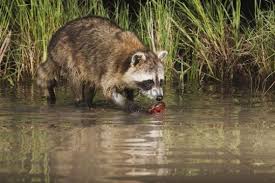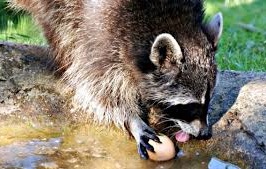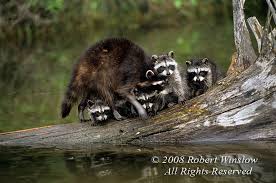
Raccoon
(Procyon lotor)

The raccoon, sometimes spelled racoon, also known as the common raccoon, North American raccoon, northern raccoon and colloquially as coon, is a medium-sized mammal native to North America. The raccoon is the largest of the procyonid family, having a body length of 40 to 70 cm (16 to 28 in) and a body weight of 3.5 to 9 kg (8 to 20 lb). Its grayish coat mostly consists of dense underfur which insulates it against cold weather. Two of the raccoon's most distinctive features are its extremely dexterous front paws and its facial mask, which are themes in the mythology of several Native American ethnic groups. Raccoons are noted for their intelligence, with studies showing that they are able to remember the solution to tasks for up to three years. The diet of the omnivorous raccoon, which is usually nocturnal, consists of about 40% invertebrates, 33% plant foods, and 27% vertebrates.
The original habitats of the raccoon are deciduous and mixed forests, but due to their adaptability they have extended their range to mountainous areas, coastal marshes, and urban areas, where some homeowners consider them to be pests. As a result of escapes and deliberate introductions in the mid-20th century, raccoons are now also distributed across mainland Europe, Caucasia, and Japan.
Though previously thought to be solitary, there is now evidence that raccoons engage in gender-specific social behavior. Related females often share a common area, while unrelated males live together in groups of up to four animals to maintain their positions against foreign males during the mating season, and other potential invaders. Home range sizes vary anywhere from 3 hectares (7.4 acres) for females in cities to 5,000 hectares (12,000 acres) for males in prairies. After a gestation period of about 65 days, two to five young, known as "kits", are born in spring. The kits are subsequently raised by their mother until dispersal in late fall. Although captive raccoons have been known to live over 20 years, their life expectancy in the wild is only 1.8 to 3.1 years. In many areas, hunting and vehicular injury are the two most common causes of death.
Conservation status
Least concern
Scientific classification |
|
| Kingdom: | Animalia |
| Phylum: | Chordata |
| Class: | Mammalia |
| Order: | Carnivora |
| Family: | Procyonidae |
| Genus: | Procyon |
| Specie: | Procyon lotor |
Description

Head to hindquarters, raccoons measure between 40 and 70 cm (16 and 28 in), not including the bushy tail which can measure between 20 and 40 cm (8 and 16 in), but is usually not much longer than 25 cm (10 in). The shoulder height is between 23 and 30 cm (9 and 12 in). The body weight of an adult raccoon varies considerably with habitat, making the raccoon one of the most variably sized mammals. It can range from 2 to 14 kilograms (4 to 30 lb), but is usually between 3.5 and 9 kilograms (8 and 20 lb). The smallest specimens are found in southern Florida, while those near the northern limits of the raccoon's range tend to be the largest (see Bergmann's rule). Males are usually 15 to 20% heavier than females. At the beginning of winter, a raccoon can weigh twice as much as in spring because of fat storage. The largest recorded wild raccoon weighed 28.4 kg (62.6 lb) and measured 140 cm (55 in) in total length, by far the largest size recorded for a procyonid.

The most characteristic physical feature of the raccoon is the area of black fur around the eyes, which contrasts sharply with the surrounding white face coloring. This is reminiscent of a "bandit's mask" and has thus enhanced the animal's reputation for mischief. The slightly rounded ears are also bordered by white fur. Raccoons are assumed to recognize the facial expression and posture of other members of their species more quickly because of the conspicuous facial coloration and the alternating light and dark rings on the tail. The dark mask may also reduce glare and thus enhance night vision. On other parts of the body, the long and stiff guard hairs, which shed moisture, are usually colored in shades of gray and, to a lesser extent, brown. Raccoons with a very dark coat are more common in the German population because individuals with such coloring were among those initially released to the wild. The dense underfur, which accounts for almost 90% of the coat, insulates against cold weather and is composed of 2 to 3 cm (0.8 to 1.2 in) long hairs.
The raccoon, whose method of locomotion is usually considered to be plantigrade, can stand on its hind legs to examine objects with its front paws. As raccoons have short legs compared to their compact torso, they are usually not able either to run quickly or jump great distances. Their top speed over short distances is 16 to 24 km/h (10 to 15 mph). Raccoons can swim with an average speed of about 5 km/h (3 mph) and can stay in the water for several hours. For climbing down a tree headfirst an unusual ability for a mammal of its size a raccoon rotates its hind feet so they are pointing backwards. Raccoons have a dual cooling system to regulate their temperature; that is, they are able to both sweat and pant for heat dissipation.
Raccoon skulls have a short and wide facial region and a voluminous braincase. The facial length of the skull is less than the cranial, and their nasal bones are short and quite broad. The auditory bullae are inflated in form, and the sagittal crest is weakly developed. The dentition 40 teeth is adapted to their omnivorous diet: the carnassials are not as sharp and pointed as those of a full-time carnivore, but the molars are not as wide as those of a herbivore. The penis bone of males is about 10 cm (4 in) long and strongly bent at the front end. Juvenile males are distinguished from mature males by the shape and extrusibility of their penis bones. Seven of the thirteen identified vocal calls are used in communication between the mother and her kits, one of these being the birdlike twittering of newborns.
Habitat

Although they have thrived in sparsely wooded areas in the last decades, raccoons depend on vertical structures to climb when they feel threatened. Therefore, they avoid open terrain and areas with high concentrations of beech trees, as beech bark is too smooth to climb. Tree hollows in old oaks or other trees and rock crevices are preferred by raccoons as sleeping, winter and litter dens. If such dens are unavailable or accessing them is inconvenient, raccoons use burrows dug by other mammals, dense undergrowth or tree crotches. In a study in the Solling range of hills in Germany, more than 60% of all sleeping places were used only once, but those used at least ten times accounted for about 70% of all uses. Since amphibians, crustaceans, and other animals found around the shore of lakes and rivers are an important part of the raccoon's diet, lowland deciduous or mixed forests abundant with water and marshes sustain the highest population densities. While population densities range from 0.5 to 3.2 animals per square kilometer (1.3 to 8.3 animals per square mile) in prairies and do not usually exceed 6 animals per square kilometer (15.5 animals per square mile) in upland hardwood forests, more than 20 raccoons per square kilometer (51.8 animals per square mile) can live in lowland forests and marshes.
Distribution
Raccoons are common throughout North America from Canada to Panama, where the subspecies Procyon lotor pumilus coexists with the crab-eating raccoon (Procyon cancrivorus). The population on Hispaniola was exterminated as early as 1513 by Spanish colonists who hunted them for their meat. Raccoons were also exterminated in Cuba and Jamaica, where the last sightings were reported in 1687. When they were still considered separate species, the Bahamas raccoon, Guadeloupe raccoon and Tres Marias raccoon were classified as endangered by the IUCN in 1996.There is evidence that in pre-Columbian times raccoons were numerous only along rivers and in the woodlands of the Southeastern United States. As raccoons were not mentioned in earlier reports of pioneers exploring the central and north-central parts of the United States, their initial spread may have begun a few decades before the 20th century. Since the 1950s, raccoons have expanded their range from Vancouver Island formerly the northernmost limit of their range far into the northern portions of the four south-central Canadian provinces. New habitats which have recently been occupied by raccoons (aside from urban areas) include mountain ranges, such as the Western Rocky Mountains, prairies and coastal marshes. After a population explosion starting in the 1940s, the estimated number of raccoons in North America in the late 1980s was 15 to 20 times higher than in the 1930s, when raccoons were comparatively rare. Urbanization, the expansion of agriculture, deliberate introductions, and the extermination of natural predators of the raccoon have probably caused this increase in abundance and distribution.
As a result of escapes and deliberate introductions in the mid-20th century, the raccoon is now distributed in several European and Asian countries. Sightings have occurred in all the countries bordering Germany, which hosts the largest population outside of North America. Another stable population exists in northern France, where several pet raccoons were released by members of the U.S. Air Force near the Laon-Couvron Air Base in 1966. Furthermore, raccoons have been known to be in the area around Madrid since the early 1970s. In 2013 the city authorized "the capture and death of any specimen" found. It is also present in Italy, with one reproductive population in Lombardy.
About 1,240 animals were released in nine regions of the former Soviet Union between 1936 and 1958 for the purpose of establishing a population to be hunted for their fur. Two of these introductions were successful one in the south of Belarus between 1954 and 1958, and another in Azerbaijan between 1941 and 1957. With a seasonal harvest of between 1,000 and 1,500 animals, in 1974 the estimated size of the population distributed in the Caucasus region was around 20,000 animals and the density was four animals per square kilometer (10 animals per square mile).
Behavior
Studies in the 1990s by the ethologists Stanley D. Gehrt and Ulf Hohmann suggest that raccoons engage in gender-specific social behaviors and are not typically solitary, as was previously thought. Related females often live in a so-called "fission-fusion society", that is, they share a common area and occasionally meet at feeding or resting grounds. Unrelated males often form loose male social groups to maintain their position against foreign males during the mating season or against other potential invaders. Such a group does not usually consist of more than four individuals. Since some males show aggressive behavior towards unrelated kits, mothers will isolate themselves from other raccoons until their kits are big enough to defend themselves. With respect to these three different modes of life prevalent among raccoons, Hohmann called their social structure a "three class society". Samuel I. Zeveloff, professor of zoology at Weber State University and author of the book Raccoons: A Natural History, is more cautious in his interpretation and concludes at least the females are solitary most of the time and, according to Erik K. Fritzell's study in North Dakota in 1978, males in areas with low population densities are solitary as well.The shape and size of a raccoon's home range varies depending on age, sex, and habitat, with adults claiming areas more than twice as large as juveniles. While the size of home ranges in the inhospitable habitat of North Dakota's prairies lie between 7 and 50 km2 (3 and 20 sq mi) for males and between 2 and 16 km2 (1 and 6 sq mi) for females, the average size in a marsh at Lake Erie was 0.5 km2 (0.19 sq mi). Irrespective of whether the home ranges of adjacent groups overlap, they are most likely not actively defended outside the mating season if food supplies are sufficient. Odor marks on prominent spots are assumed to establish home ranges and identify individuals. Urine and feces left at shared raccoon latrines may provide additional information about feeding grounds, since raccoons were observed to meet there later for collective eating, sleeping and playing.
Concerning the general behavior patterns of raccoons, Gehrt points out that "typically you'll find 10 to 15 percent that will do the opposite" of what is expected.
Diet

Though usually nocturnal, the raccoon is sometimes active in daylight to take advantage of available food sources. Its diet consists of about 40% invertebrates, 33% plant material and 27% vertebrates. Since its diet consists of such a variety of different foods, Zeveloff argues the raccoon "may well be one of the world's most omnivorous animals". While its diet in spring and early summer consists mostly of insects, worms, and other animals already available early in the year, it prefers fruits and nuts, such as acorns and walnuts, which emerge in late summer and autumn, and represent a rich calorie source for building up fat needed for winter. Contrary to popular belief, raccoons only occasionally eat active or large prey, such as birds and mammals. They prefer prey that is easier to catch, specifically fish, amphibians and bird eggs. When food is plentiful, raccoons can develop strong individual preferences for specific foods. In the northern parts of their range, raccoons go into a winter rest, reducing their activity drastically as long as a permanent snow cover makes searching for food impossible.
Reproduction

Raccoons usually mate in a period triggered by increasing daylight between late January and mid-March. However, there are large regional differences which are not completely explicable by solar conditions. For example, while raccoons in southern states typically mate later than average, the mating season in Manitoba also peaks later than usual in March and extends until June. During the mating season, males restlessly roam their home ranges in search of females in an attempt to court them during the three- to four-day period when conception is possible. These encounters will often occur at central meeting places. Copulation, including foreplay, can last over an hour and is repeated over several nights. The weaker members of a male social group also are assumed to get the opportunity to mate, since the stronger ones cannot mate with all available females. In a study in southern Texas during the mating seasons from 1990 to 1992, about one third of all females mated with more than one male. If a female does not become pregnant or if she loses her kits early, she will sometimes become fertile again 80 to 140 days later.
After usually 63 to 65 days of gestation (although anywhere from 54 to 70 days is possible), a litter of typically two to five young is born. The average litter size varies widely with habitat, ranging from 2.5 in Alabama to 4.8 in North Dakota. Larger litters are more common in areas with a high mortality rate, due, for example, to hunting or severe winters. While male yearlings usually reach their sexual maturity only after the main mating season, female yearlings can compensate for high mortality rates and may be responsible for about 50% of all young born in a year. Males have no part in raising young. The kits (also called "cubs") are blind and deaf at birth, but their mask is already visible against their light fur. The birth weight of the about 10 cm (4 in)-long kits is between 60 and 75 g (2.1 and 2.6 oz). Their ear canals open after around 18 to 23 days, a few days before their eyes open for the first time. Once the kits weigh about 1 kg (2 lb), they begin to explore outside the den, consuming solid food for the first time after six to nine weeks. After this point, their mother suckles them with decreasing frequency; they are usually weaned by 16 weeks. In the fall, after their mother has shown them dens and feeding grounds, the juvenile group splits up. While many females will stay close to the home range of their mother, males can sometimes move more than 20 km (12 mi) away. This is considered an instinctive behavior, preventing inbreeding. However, mother and offspring may share a den during the first winter in cold areas.
Zoológico de Vallarta A. C.
Leave your comments, your opinion is important to us

